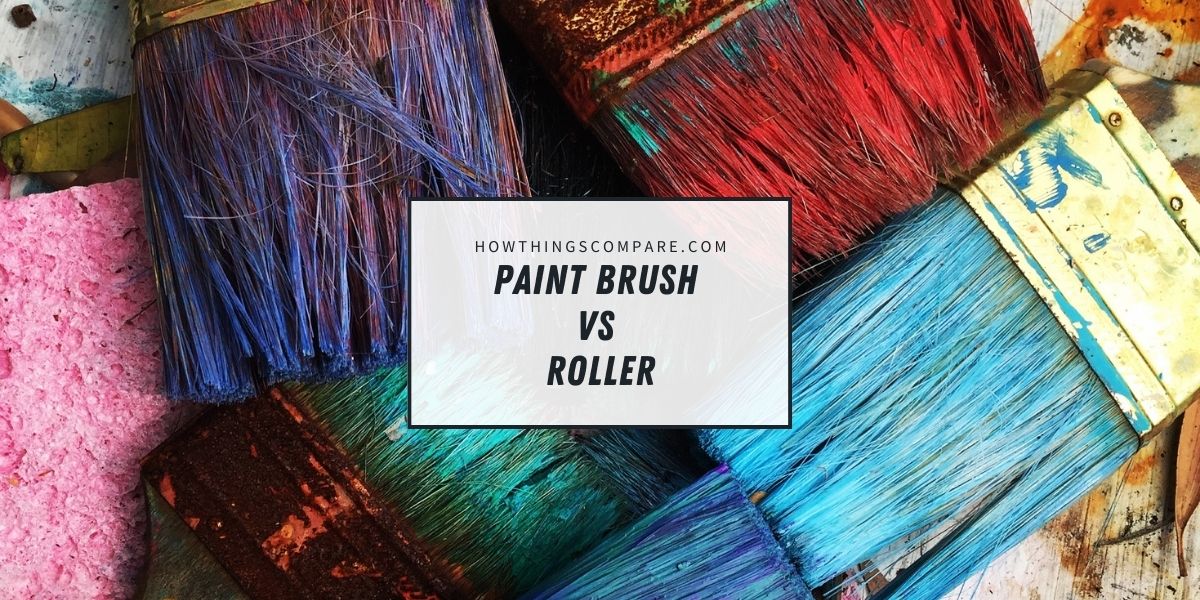When it’s time to apply paint, the size you need to cover and the material you’re covering will have a big impact on the look of the final project. While a brush will generally take longer, it may be the best choice if the surface is very rough. However, if you need to cove something heavily textured, a thick nap roller can be quite effective.

What Area Do You Need to Cover?
If you’re painting a 10 foot x 20 foot room and the walls are consistent, a roller will greatly speed the process. You’ll get a much smoother finish and be finished sooner. However, if the walls you’re covering are not smooth, a brush or brush and roller pattern may be more effective. Deeply uneven walls that require both can include those that are
- paneled
- rough concrete
- heavily textured
No matter what, you will need an edging tool. A brush and quality tape can be an effective pairing to create a clean corner at roof and wall or along baseboard trim. Do take the time to edge with a brush as you roll; nearly dry paint applied with a roller will gum up if you go over it with a roller. You want to work the whole wall wet for a clean finish.

Surface Concerns
Smooth walls, such as new or freshly patched sheetrock, may need priming for a top quality paint job. Do take the time to prime the walls if you have recently patched any holes; joint and patching compounds take paint differently than the painted sheetrock around the patch. If you don’t prime, your patch will reflect the light differently and may be more noticeable than the holes.
If you’re painting the wooden trim in your home, a brush will make the task easier. In tight spaces, do your best to spend more time masking and preparing than you do actually painting. For those painting wooden doors and cabinets, take off what you can from the vertical and lay them flat. A fine foam roller can be an ideal tool for priming and painting your doors and cabinets.

Roller Types: Nap and Material Considerations
The deeper the texture of your walls, the thicker nap you will need on your roller. For example, you may have a heavy texture on your walls or a rough concrete wall in a basement that needs painted. A roller with a high nap will deliver more paint to the wall and allow you to fill up the texture more quickly as you roll.
Take the time to load your roller properly. A deep paint pan or a bucket screen on a five gallon bucket will allow you to fully fill the roller. A thick roller cover on a smooth wall will create a lot of paint drips or runs until you get the touch; if you’re painting one rough wall and three smooth, practice on the smooth to get the touch.
Rolling paint is quick but messy. Do make sure to mask your floors and trim before you start. Try to work the project quickly; rollers are difficult to completely clean and will have a different texture when they dry.

Brush Benefits: Applications and Area
Consider investing in a few cheap nylon bristle brushes for a really rough wall. For example, if you’re painting rough concrete or raw plaster, using a heavy nap roller and a brush that you can use to scrub that first coat of primer into the porous and rough surface may be labor intensive, but the top coat will be much cleaner.
Be ready to toss these cheaper tools if you need to apply
- an oil based primer
- a stain-blocking primer
- a mold-inhibiting layer of paint
Handling a brush roughly and forcing paint into a rough texture will destroy the tips of the brush bristles. It will continue to hold paint, but you will have no control over the finish. Additionally, if you have to use a brush to force paint, it will push paint into the ferrule and make it very hard to clean the brush when you’re done.
Do invest in quality brushes with a finely cut edge for applying the top coat of latex paint. Make sure that you buy brushes for the type of paint you’re using; the process of cleaning up oil-based paint can destroy the tips of some quality latex brushes.

Sacrificial Tools
If you love to paint or plan to do a lot of painting, be prepared to sacrifice a few tools. For example, to patch your holes and finish your sheetrock effectively, you will want a quality taping knife that will need cleaned each time, but you’ll also need sandpaper you can discard when it’s worn.
Once a roller or brush has been used for priming, you won’t want to use them for the top coat of latex. Be prepared to toss roller covers if they develop chunks of dried paint.

